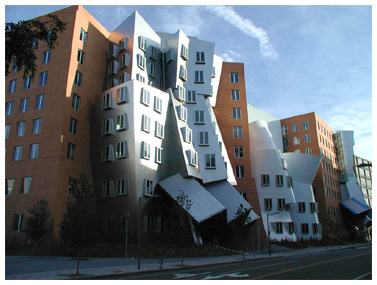 James S. Russell wrote an article last week for Bloomberg.com about what a mistake it is to criticize those who mix art with function and advance innovative design in buildings. The story was triggered by a lawsuit filed by MIT against the architect and against the builder of the Stata Center research lab on MIT’s campus in Cambridge, Massachusetts.
James S. Russell wrote an article last week for Bloomberg.com about what a mistake it is to criticize those who mix art with function and advance innovative design in buildings. The story was triggered by a lawsuit filed by MIT against the architect and against the builder of the Stata Center research lab on MIT’s campus in Cambridge, Massachusetts.
The Ray and Maria Stata Center was designed by architect Frank O. Gehry and constructed by builder Beacon Skanska of Skanska USA Building Inc. It’s distinctive appearance with astonishing shapes and angles is typical of Gehry’s work, which often causes observers to ponder how his buildings can stand, let alone function. But that is precisely what the Stata Center does. Its interior space houses collaborating-friendly spaces which encourage the creativity of the minds who work in them.
After the center opened in 2004, it developed some structural problems including, leaking, cracking, drainage problems and growing mold particularly around the outdoor rooftop amphitheater. MIT filed the lawsuit in 2007, which was settled in April 2010 for an undisclosed amount of money in addition to the repairs which have been completed.
The article points out that any building can develop problems which must be resolved after construction is completed, but not every problem results in a lawsuit. Distinct and advanced projects such as the Stata Center are sometimes criticized for the design risks they take. Witold Rybczynski, architecture critic at the website Slate, wrote that “experiments belong in the laboratory, not on the construction site.” Russell responds, “He would be correct if there were a laboratory for U.S. construction, but the fragmented industry supports almost no research, nor does the government. To advance the state of the art means to build innovation into real buildings in real time.”
The lawsuit implies that designers and builders should play it safe, erecting buildings in traditional ways, which for a research lab would be to “line up benches in regimented rows and crush spirits with long dim hallways”.
Instead, the Stata Center is designed with creativity in mind. Its connecting and open spaces bring people of various disciplines together to promote interfacing of ideas. This would not be possible without forward thinking developers and designers. This is the opinion of Russell as he writes:
"The best architects and owners recognize that needs, technologies and modes of expression all evolve over time. We should be expecting a great deal of buildings these days. They must appropriately house our increasingly complex endeavors with sensitivity to energy, climate change and whatever else the future throws at us."
I couldn’t agree more!
Photograph courtesy of Wikimedia Commons.



Add new comment